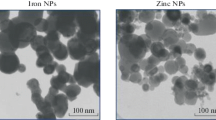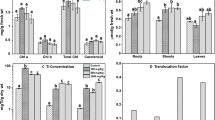Abstract
Two experiments were done in 2008 and 2009 to study the effects of magnetic field and silver nanoparticles on fodder maize (Zea mays L.). These experiments were done with seven treatments based on a randomized complete block design in four replications. The treatments were as follows: magnetic field and silver nanoparticles + Kemira fertilizer (T1), magnetic field and silver nanoparticles + Humax fertilizer (T2), magnetic field and silver nanoparticles (T3), Kemira fertilizer (T4), Librel fertilizer (T5), Humax fertilizer (T6), and a control (T7). Results showed that fresh yield was higher in treatments T3 and T4. Treatments T3 and T4 had increased maize fresh yields of 35 and 17.5 % in comparison to the control, respectively. The dry matter yield of those plants exposed to magnetic field and silver nanoparticles was significantly higher than that from any of the other treatments. Magnetic field and silver nanoparticle treatments (T3 and T1) showed higher percentages for ears, and the lowest percentages were found in treatments T7 and T5. In general, the soil conditions for crop growth were more favorable in 2009 than in 2008, which caused the maize to respond better to treatments tested in the study; therefore, treatments had more significant effects on studied traits in 2008 than in 2009.

Similar content being viewed by others
References
Gonzalez-melendi P, Fernandez-pacheco R, Coronado MJ, Coredor E, Testillano PS, Risueno MC, Marquina C, Ibarra MR, Rubiales D, Perez-Deluque A (2008) Nanoparticles as smart treatment-delivery systems in plants: assessment of different techniques of microscopy for their visualization in plant tissues. Ann Bot 101:187–195
Handy RD, Kamme F, Lead JR, Hasselov M, Owen R, Crane M (2008) The ecotoxicology and chemistry of manufactured nanoparticles. Ecotoxicology 17:287–314
Handy RD, Owen R, Valsami-Jones E (2008) The ecotoxicology of nanoparticles and nanomaterials: current status, knowledge gaps, challenges, and future needs. Ecotoxicology 17:315–325
Auffan M, Rose J, Wiesner MR, Bottero J (2009) Chemical stability of metallic nanoparticles: a parameter controlling their potential cellular toxicity in vitro. Environ Pollut 157:1127–1133
Zhu H, Han J, Xiao QJ, Jin Y (2008) Uptake, translocation, and accumulation of manufactured iron oxide nanoparticles by pumpkin plants. J Environ Monit 10:685–784
Lin D, Xing B (2007) Phytotoxicity of nanoparticles: inhibition of seed germination and root growth. Environ Pollut 150:243–250
Musante C, White JC (2010) Toxicity of silver and copper to Cucurbita pepo: differential effects of nano and bulk-size particles. Environ Toxicol. doi:10.1002/tox. 1-8
Lei Z, Mingyu S, Xiao W, Chao L, Chunxiang Q, Liang C, Hao H, Xiao-qing L, Fashui H (2008) Antioxidant stress is promoted by nano-anatase in spinach chloroplasts under UV-B radiation. Biol Trace Elem Res 121:69–79
Lu J, Cao P, He S, Liu J, Li H, Cheng G, Ding Y, Joyce DC (2010) Nano-silver pulse treatments improve water relations of cut rose cv. movie star flowers. Postharvest Biol Technol 57:196–202
Altman SA, Solomos T (1995) Differential respiratory and morphological responses of carnations pulsed or continuously treated with silver thiosulfate. Postharvest Biol Technol 5:331–343
Ichimura K, Yoshioka S, Yumoto-Shimizu H (2008) Effects of silver thiosulfate complex (STS), sucrose and combined pulse treatments on the vase life of cut snapdragon flowers. Environ Control Biol 46:155–162
Van Ieperen W (2007) Ion-mediated changes of xylem hydraulic resistance in plant: fact or fiction? Trends Plant Sci 12:137–142
Ohkawa K, Kasahara Y, Suh J (1999) Mobility and effects on vase life of silver containing compounds in cut rose flowers. Hort Sci 34:112–113
Koontz HV, Berle KL (1980) Silver uptake, distribution and effect on calcium, phosphorus and sulfur uptake. Plant Physiol 65:336–339
Podlesny J, Misiak L, Koper R (2001) Concentration of free radicals in faba bean seeds after the pre-sowing treatment of the seeds with laser light. Int Agrophysics 15:185–189
Podlesny J, Pietruszewski S, Podleoen A (2004) Efficiency of the magnetic treatment of broad bean seeds cultivated under experimental plot conditions. Int Agrophysics 18:65–71
Aladjadjiyan A (2010) Influence of stationary magnetic field on lentil seeds. Int Agrophysics 24:321–324
Cakmak T, Dumlupinar R, Erdal S (2009) Acceleration of germination and early growth of wheat and bean seedlings grown under various magnetic field and osmotic conditions. Bioelectromagnetics 30:1–10
Aladjadjiyan A (2002) Study of the influence of magnetic field on some biological characteristics of Zea mays. J Central Eur Agric 3:89–94
Esitken A, Turan M (2004) Alternating magnetic field effects on yield and plant nutrient element composition of strawberry (Fragaria ananassa cv. Camarosa). Soil Plant Sci 54:135–139
Page AL, Miller RH, Keeney DR (1982) Methods of soil analysis. Part2: Chemical and microbiological properties. Am Soc Agronomy, Soil Sci Am Publisher, Madison
Lindsay WL, Norvell WA (1978) Development of a DTPA soil test for zinc, iron, manganese, and copper. Soil Sci Soc Am J 42:421–428
Richards LA (1954) Diagnosis and improvement of saline and alkali soil. USDA. Agriculture Handbook No. 60. Washington, USA
Florez M, Carbonell MV, Martinez E (2007) Exposure of maize seeds to stationary magnetic fields: effects on germination and early growth. Environ Exp Bot 59:68–75
Lu CM, Zhang CYWuJQ, Tao MX (2002) Research of the effect of nanometer on germination and growth enhancement of Glycine max and its mechanism. Soybean Sci 21:168–172
Peralta-Videa JR, Zhao L, Lopez-Moreno ML, dela Rosa G, Hong J, Gardea-Torresdey JL (2011) Nanomaterials and the environment: a review for the biennium 2008–2010. J Hazard Mater 186:1–15
Vashisth A, Nagarajan S (2008) Exposure of seeds to static magnetic field enhances germination and early growth characteristics in chickpea (Cicer arietinum L.). Bioelectromagnetics 29:571–578
De Souza A, Garcí D, Sueiro L, Gilart F, Porras E, Licea L (2006) Pre-sowing magnetic treatments of tomato seeds increase the growth and yield of plants. Bioelectromagnetics 27:247–257
Racuciu M, Creanga D, Horga I (2006) Plant growth under static magnetic field influence. Romanian J Phys 53:353–359
Hong F, Zhou J, Liu C, Yang F, Wu C, Zheng L, Yang P (2005) Effects of nano-TiO2 on photochemical reaction of chloroplasts of spinach. Biol Trace Elem Res 105:269–279
Hong F, Yang F, Liu C, Gao Q, Wan Z, Gu F, Wu C, Ma Z, Zhou J, Yang P (2005) Influence of nano-TiO2 on the chloroplast aging of spinach under light. Biol Trace Elem Res 104:249–260
Yang F, Liu C, Gao F, Su M, Wu X, Zheng L, Hong F, Yang P (2007) The improvement of spinach growth by nano-anatase TiO2 treatment is related to nitrogen photoreduction. Biol Trace Elem Res 119:77–88
Zheng L, Hong F, Lu S, Liu C (2005) Effect of nano-TiO2 on strength of naturally aged seeds and growth of spinach. Biol Trace Elem Res 105:83–91
Author information
Authors and Affiliations
Corresponding author
Rights and permissions
About this article
Cite this article
Berahmand, A.A., Ghafariyan Panahi, A., Sahabi, H. et al. Effects Silver Nanoparticles and Magnetic Field on Growth of Fodder Maize (Zea mays L.). Biol Trace Elem Res 149, 419–424 (2012). https://doi.org/10.1007/s12011-012-9434-5
Received:
Accepted:
Published:
Issue Date:
DOI: https://doi.org/10.1007/s12011-012-9434-5




